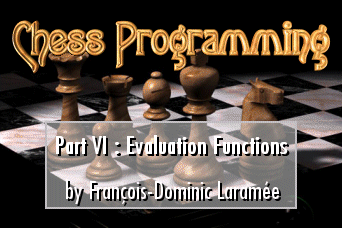11/10 - 11/12 @ Montréal, Canada
12/5 - 12/7 @ Shanghai, China
12/24 - 12/27
2/28 - 3/4 @ San Francisco, CA
More events...
2406 articles in the reference section.
Help us fight cancer!
Join SETI Team GDNet!

|
Pawn FormationsChess grandmasters often say that pawns are the soul of the game. While this is far from obvious to the neophyte, the fact that great players often resign over the loss of a single pawn clearly indicates that they mean it! Chess literature mentions several types of pawn features, some valuable, some negative. My program looks at the following:
A final note on pawn formations: a passed pawn is extremely dangerous if it has a rook standing behind it, because any piece that would capture the pawn is dead meat. My program therefore scores a passed pawn as even more valuable if there is a rook on the same file and behind the pawn. King Safety and TropismWe have already touched on king safety earlier: in the opening and middle game, protecting the king is paramount, and castling is the best way to do it. However, in the endgame, most of the pieces on both sides are gone, and the king suddenly becomes one of your most effective offensive assets! Leaving him behind a wall of pawns is a waste of resources. As for "tropism", it is a measure of how easy it is for a piece to attack the opposing king, and is usually measured in terms of distance. The exact rules used to compute tropism vary by piece type, but they all amount to this: the closer you are to the opposing king, the more pressure you put on it. |
|
|
|
|